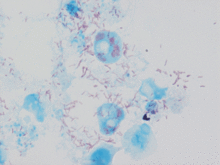| Rickettsia conorii | |
|---|---|

| |
| Rickettsia conorii observed in Vero cells (red rods; magnification ×1,000)[1] | |
| Scientific classification | |
| Domain: | Bacteria |
| Phylum: | Pseudomonadota |
| Class: | Alphaproteobacteria |
| Order: | Rickettsiales |
| Family: | Rickettsiaceae |
| Genus: | Rickettsia |
| Species group: | Spotted fever group |
| Species: | R. conorii
|
| Binomial name | |
| Rickettsia conorii | |
Rickettsia conorii is a Gram-negative, obligate intracellular bacterium of the genus Rickettsia that causes human disease called boutonneuse fever, Mediterranean spotted fever, Israeli tick typhus, Astrakhan spotted fever, Kenya tick typhus, Indian tick typhus, or other names that designate the locality of occurrence while having distinct clinical features.[3][4] It is a member of the spotted fever group and the most geographically dispersed species in the group, recognized in most of the regions bordering on the Mediterranean Sea and Black Sea, Israel, Kenya, and other parts of North, Central, and South Africa, and India.[3] The prevailing vector is the brown dog tick, Rhipicephalus sanguineus. The bacterium was isolated by Emile Brumpt in 1932[5] and named after A. Conor, who in collaboration with A. Bruch, provided the first description of boutonneuse fever in Tunisia in 1910.[6]
The genome of the bacterium has been sequenced and four subspecies have been identified.[7][8][9][10][11]
Genomes of intracellular or parasitic bacteria undergo massive reduction compared to their free-living relatives. Examples include Rickettsia for alpha proteobacteria, T. whipplei for Actinobacteria, Mycoplasma for Firmicutes (the low G+C content Gram-positive), and Wigglesworthia and Buchnera for gamma proteobacteria.[12]
Some of the largest virions like Megavirus chilensis, Pandoravirus, Pithovirus and mimivirus are comparable in size to miniature bacteria like T. whipplei and Rickettsia conorii.
YouTube Encyclopedic
-
1/2Views:19 3532 277
-
Rickettsial infections.avi
-
Rickettsia Infections Review - Ileana Acevedo, MD
Transcription
References
- ^ Rovery C, Brouqui P, Raoult D (2008). "Questions on Mediterranean Spotted Fever a Century after Its Discovery". Emerg Infect Dis. 14 (9): 1360–1367. doi:10.3201/eid1409.071133. PMC 2603122. PMID 18760001.
- ^ Skerman, VBD; McGowan, V; Sneath, PHA, eds. (1989). Approved Lists of Bacterial Names (amended ed.). Washington, DC: American Society for Microbiology.
- ^ a b Yu, XJ; Walker, DH (2005). "Genus I. Rickettsia da Rocha-Lima 1916, 567AL". In Brenner, DJ; Krieg, NR; Staley, JT; et al. (eds.). Bergey's Manual of Systematic Bacteriology, Volume 2, Part C (2nd ed.). New York: Springer. doi:10.1007/0-387-29298-5_28 (inactive 2024-04-27).
{{cite book}}: CS1 maint: DOI inactive as of April 2024 (link) - ^ Parola, P; Paddock, CD; Raoult, D (2005). "Tick-Borne Rickettsioses around the World: Emerging Diseases Challenging Old Concepts". Clin Microbiol Rev. 18 (4): 719–756. doi:10.1128/CMR.18.4.719-756.2005. PMC 1265907. PMID 16223955.
- ^ Brumpt, E (1932). "Longevité du virus de la fièvre boutonneuse (Rickettsia conorii, n. sp.) chez la tique Rhipicephalus sanguineus". C. R. Soc. Biol. 110: 1119–1202.
- ^ Conor, A & A Bruch (1910). "Une fièvre éruptive observée en Tunisie". Bull Soc Pathol Exot Filial. 8: 492–496.
- ^ Zhu Y, Fournier PE, Eremeeva M, Raoult D (2005). "Proposal to create subspecies of Rickettsia conorii based on multi-locus sequence typing and an emended description of Rickettsia conorii". BMC Microbiol. 5: 11. doi:10.1186/1471-2180-5-11. PMC 1079849. PMID 15766388.
- ^ Ogata H, Audic S, Renesto-Audiffren P, et al. (September 2001). "Mechanisms of evolution in Rickettsia conorii and R. prowazekii". Science. 293 (5537): 2093–8. Bibcode:2001Sci...293.2093O. doi:10.1126/science.1061471. PMID 11557893. S2CID 35985908.
- ^ Sentausa E, El Karkouri K, Robert C, Raoult D, Fournier PE (June 2012). "Genome sequence of Rickettsia conorii subsp. indica, the agent of Indian tick typhus". J. Bacteriol. 194 (12): 3288–9. doi:10.1128/JB.00462-12. PMC 3370856. PMID 22628514.
- ^ Sentausa E, El Karkouri K, Robert C, Raoult D, Fournier PE (September 2012). "Genome sequence of Rickettsia conorii subsp. caspia, the agent of Astrakhan fever". J. Bacteriol. 194 (17): 4763–4. doi:10.1128/JB.00992-12. PMC 3415478. PMID 22887666.
- ^ Sentausa E, El Karkouri K, Robert C, Raoult D, Fournier PE (September 2012). "Genome sequence of Rickettsia conorii subsp. israelensis, the agent of Israeli spotted fever". J. Bacteriol. 194 (18): 5130–1. doi:10.1128/JB.01118-12. PMC 3430316. PMID 22933760.
- ^ Raoult, Didier; Ogata, Hiroyuki; Audic, Stéphane; Robert, Catherine; Suhre, Karsten; Drancourt, Michel; Claverie, Jean-Michel (2003). "Tropheryma whipplei Twist: A Human Pathogenic Actinobacteria with a Reduced Genome". Genome Research. 13 (8): 1800–1809. doi:10.1101/gr.1474603. PMC 403771. PMID 12902375.
Further reading
- Fournier PE, Zhu Y, Ogata H, Raoult D (December 2004). "Use of Highly Variable Intergenic Spacer Sequences for Multispacer Typing of Rickettsia conorii Strains". J. Clin. Microbiol. 42 (12): 5757–66. doi:10.1128/JCM.42.12.5757-5766.2004. PMC 535242. PMID 15583310.
- La Manna, Torina A, Agnone A (November 2013). "Detection of Natural Killer T Cells in Mice Infected with Rickettsia conorii". 60: 80–85.
{{cite journal}}: Cite journal requires|journal=(help)CS1 maint: multiple names: authors list (link)
